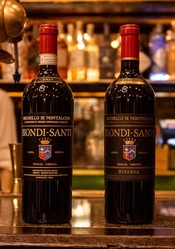What happens in the life of any organism when its continuity is interrupted? Does it adapt, and, if so, what path will it take?
That Darwinian question lingered in the evening air recently, as, on the outside, Manhattan was experiencing its first snowfall of the season – a modest and slushy affair arriving just as February was closing its books – while inside the Grand Soho, a block off Canal Street, two wines were the centerpiece of an

impressive tasting. One wine still had a foot in the past, while the other was taking the first step into the future.
Both were produced by well-known, well-respected Biondi Santi, whose history is part of the catechism for any student learning Tuscan wines. During the late 1880s, the then-eponymous, family-owned winery became a beacon for showing how great Sangiovese-based wines in the Montalcino region could be. In the 1900s, it created the formula for what were to become the modern, collectible Brunellos by eschewing the addition of white and other grapes, as had been the tradition here and in Chianti Classico, as well as any governo from dried grapes.
But a decade ago, inheritance problems arose when the winery was being handed off from one generation to the next that partially destroyed its thread of continuity. A majority stake was sold to the French wine conglomerate, EPI, in 2017, although Jacopo Biondi-Santi and his son, Tancredi, agreed to stay on for while before leaving to manage a family property elsewhere in Tuscany.
The two bottles that awaited us (a couple of dozen wine writers inside a hotel meeting room) were the two most-recent vintages of Biondi Santi, the 2017 Brunello di Montalcino and the 2016 Brunello di Montalcino Riserva.
“We will be presenting the first wine produced under the new management, the first Biondi Santi produced after the French came to Tuscany,” Biondi Santi CEO

Giampiero Bertolino told me. “The question everyone has been asking is, what will they do at Montalcino?”
Usually, when there is regime change at any winery, especially one with a long history in the same family, the most visible immediate changes will be those taken at the top – the running of the enterprise itself – rather than in these first wines. Add to that the fact that the two wines to be tasted came from different vintages, and one is a Riserva and other is not.
Still, I was curious to see what could be teased out from tasting the two.
We started with the youngest, the 2017 “everyday” Brunello, if any Brunello can be called “everyday.” There was not much nose, other than a few whiffs of tart fruits, even after working the glass. On the palate, the structure was lean with some leathery notes, though the fruit – mainly black raspberries – was not as tart as the nose might have indicated. At first the dusty tannins seemed negligible, but after a few sips (I had no interest in spitting), I found them pleasantly sneaking up on me. There was a lot of minerality, mainly the stony sort, and the elegant barrel notes, which I very much enjoyed, came almost as an after-thought in the after-taste. If I were to give it a rating in that less-than-pristine setting, it would be in 92-93 range.
The much darker 2016 Riserva had considerably more depth in aromas which were mostly reflected in the taste. It is a big wine, though certainly not one lacking in elegance, as well as an aggressive and muscular one in a good sense, with lots of tannins to serve notice this is still a baby, if a robust one. The flavors are of very mature, dark berries with a few red-fruit notes. I think this one would be in the 95-96 point range, although I wish I could have re-tasted the following morning from a kept-open bottle; alas, I was not given one to take to bed with me.
According to Bertolino, there will not be a Riserva made in 2017, so we will have to wait another couple of years – and hopefully for another invitation, as the 2017 Riserva fetches more than $600 a bottle – to see if there have been any serious changes in style. I would think that, with investments, the quality could even improve. That being said, based on this all-too-brief encounter, I think the new ownership will try to emphasize elegance over power in future Riservas. With global warming, that might be more difficult, although, as Bertolino points out, the estate is located on the cooler, northern side of the low mountains around Montalcino.
Production under the new ownership can potentially increase, as EPI has added an additional six hectares of vineyards to raise the holdings to 33 (82 acres). However, some replanting will affect how much wine will be produced in the next few years, as can decisions about the proportions to allot to each of the two primary wines.
As I have noted before, sometimes the secondary market – where a wine is purchased and re-sold, generally at auction – is the tail that eventually wags the dog – the wine’s primary release price to distributors and importers. So I decided to ask Liv-ex what wine investors thought about recent releases of Biondi Santi – and the message is basically good news for the new owners and, most likely, for drinkers who can afford the lovely wines. Liv-ex’s verdict:
"Biondi Santi is one of the most-traded Brunello producers on the fine wine secondary market. In the last two years, Biondi Santi took 11% of trade share by value of all Brunellos traded through Liv-ex, led by BS Riserva 2015. It's worth noting the figure may be inflated by the fact that Biondi Santi trades [at a] premium compared to the average Brunello."
And so, not surprisingly, the partly new/partly old Biondi Santi is in good, if slightly more-commercial, hands. Although I feel that family ownership is generally over-romanticized as a quality factor, Tuscany does have its share of them that have lasted for centuries, from “A” (Antinori) to “F” (Frescobaldi), which produce vintage after vintage of superb wine. Still, some of these many-branded corporations, from “A” (Artémis Domaines) to “L” (LVMH), that own some of France’s great châteaux and domains are also family-run, albeit those families may reside in Paris, and it is unlikely that either François Pinault or Bernard Arnault ever drove a tractor through a vineyard.
The main question – the one that will always linger – with wineries these corporate families now own is what happens when inheritance or financial difficulties cause them to be divested with little of the emotional attachment that families who have lived on the property for generations might feel?
And as for Jacopo and Tancredi Biondi Santi, they are not without grapes to pick. They have relocated to another family-owned estate called Castello di Montepò in the Morellino di Scansano DOCG about 50 miles southwest of Montalcino in southern Maremma. The primary grape there, Sangiovese, if not the same clone, is what they have worked with all their lives. For a lesser-known appellation, the outcome is not a penurious one – the Jacopo Biondi Santi Castello di Montepo “Schidione” Toscana IGT sells for about $185 a bottle, and, according to wine-searcher.com, has an average rating of around 91.
So, not only should we ponder the continuity of Biondi Conti – The Estate, we should also consider the continuity of Biondi Santi – The Family. I like happy endings, so here’s one: Perhaps, in the next generation or two, if not in the current one, the Biondi Santi family name will again work its magic, and it will lead the rising Tuscan Sangiovese region of Morellino di Scansano to be spoken of in the same reverential tones as are today Chianti Classico, Vino Nobile de Montepulciano, Bolgheri, and – yes – Brunello di Montalcino.